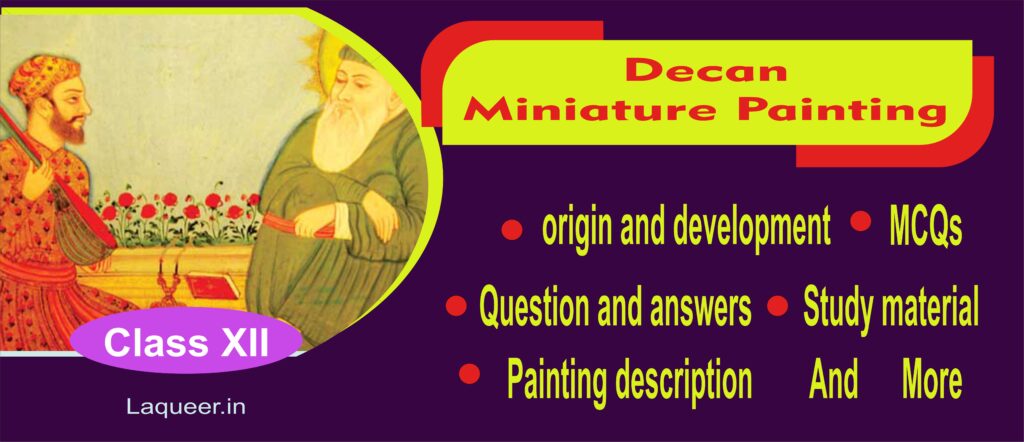
Decoding the Elegance
The Deccan School of Miniature Painting
Introduction
In the realm of Indian art, the Deccan School of Miniature Painting stands as a captivating testament to the artistic diversity that flourished in the southern regions of the subcontinent. With its unique characteristics and the emergence of various sub-schools, this art form offers a mesmerizing journey through history, culture, and creativity.
Origins and Development
The Decan School of Miniature Painting, a lesser-known yet incredibly significant artistic tradition, has its roots deeply embedded in the historical and cultural landscape of India. Emerging as a distinct artistic style in the 16th century, the Decan School evolved over time to become a fascinating blend of indigenous aesthetics and external influences. This school played a crucial role in shaping the visual culture of the Deccan plateau, leaving an indelible mark on the history of Indian art.
The origins of the Decan School of Miniature Painting can be traced back to the Bahmani Sultanate, which ruled over the Deccan region in the late medieval period. The sultans’ courts were centers of cultural and artistic patronage, attracting artists, poets, and scholars from across the region. The fusion of local Deccani traditions with Persian, Mughal, and even European artistic elements gave birth to the unique style of Decan miniature painting.
The earliest extant examples of Decan miniatures can be found in the illustrated manuscripts produced during the reign of the Bahmani and Adil Shahi dynasties. These manuscripts often depicted scenes from court life, epic stories, and religious narratives. One of the most remarkable features of the Decan style was its vibrant color palette, characterized by the use of rich, intense hues and intricate detailing.
As the Decan School of Miniature Painting matured, it witnessed a significant transformation during the rule of the Qutb Shahi dynasty in the 16th and 17th centuries. Golconda, the capital of the Qutb Shahi dynasty, emerged as a vibrant cultural hub, fostering artistic innovation and cross-cultural exchanges. The Decan miniatures from this period often displayed a distinctive blend of Persian and Indian artistic traditions, reflecting the diverse influences of the region.
One of the hallmarks of the Decan School was its emphasis on portraiture. The portraits from this school captured the individuality and character of their subjects with remarkable precision. These portraits were often depicted against lush landscapes, reflecting the artists’ keen observation of nature. Moreover, the inclusion of European motifs and elements in some paintings illustrated the cosmopolitan nature of the Deccan courts.
The Decline of the Decan School of Miniature Painting can be attributed to various historical factors. The downfall of the Qutb Shahi dynasty, coupled with political instability and invasions, resulted in the dispersal of artists and the decline of artistic patronage. Moreover, the rise of the Mughal Empire further overshadowed the Decan School, as the Mughals’ own artistic traditions gained prominence.
In spite of its decline, the legacy of the Decan School of Miniature Painting continues to resonate in contemporary times. Art historians and scholars have recognized its unique contributions to Indian art and culture. The intricate detailing, vibrant color palette, and fusion of artistic traditions make Decan miniatures highly sought after by collectors and connoisseurs.
Characteristics of Deccan Miniature Paintings:
- Vibrant Color Palette: Deccan miniatures are known for their vibrant and bold use of colors. The rich and vivid hues, often achieved using natural pigments, create a striking visual impact.
- Intricate Details: The miniatures are characterized by their intricate detailing, which includes delicate patterns, fine lines, and ornate decorations. These details add depth and complexity to the compositions.
- Local Flavors: The Deccan miniatures often incorporate elements from the region’s culture and architecture. The use of intricate geometric patterns, architectural motifs, and local costumes adds a unique regional identity to the art.
- Depiction of Women: Deccan miniatures often showcase women as central figures, portraying them as strong, graceful, and adorned with exquisite jewelry and garments.
- Landscape and Nature: These miniatures frequently feature lush landscapes, serene gardens, and flowing rivers, capturing the natural beauty of the Deccan plateau.
Sub-Schools of the Deccan Miniature Painting:
- Bijapur School: Under the patronage of the Adil Shahis of Bijapur, this sub-school focused on intricate detailing, particularly in architectural elements. The depiction of battle scenes, courtly life, and Sufi mysticism were prominent themes.
- Golconda School: Flourishing under the Qutb Shahis of Golconda, this sub-school emphasized a rich color palette and a delicate rendering of figures. Portraits, particularly of rulers and nobles, were a key feature.
- Hyderabad School: Emerging after the fall of the Qutb Shahis, the Hyderabad sub-school continued the legacy of the Deccan art. It introduced European elements like shading and perspective while maintaining the region’s unique style.
- Mysore School: The Deccan influence extended to Mysore, resulting in the Mysore sub-school. Known for its depiction of mythological themes, this school employed a harmonious blend of color and intricate designs.
Legacy and Influence
The Deccan School of Miniature Painting left an indelible mark on the history of Indian art. Its fusion of various cultural elements and distinctive regional features showcased the diversity and richness of the Deccan region. Moreover, its influence extended beyond paintings, shaping the aesthetics of textiles, architecture, and decorative arts.
Conclusion
The Deccan School of Miniature Painting is a captivating testament to the artistic ingenuity that flourished in the southern regions of India. Through its unique features and sub-schools, it offers a window into the culture, history, and creative brilliance that defined the Deccan plateau. As we explore these miniature marvels today, we pay homage to an art form that continues to resonate with the soul of a region that has been a cradle of artistic expression for centuries.